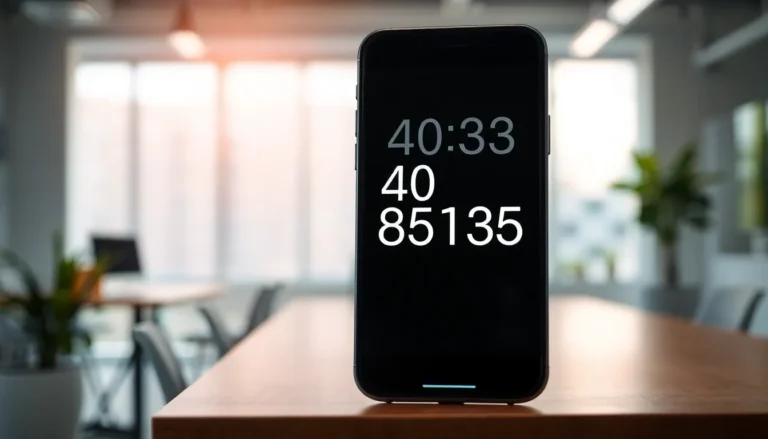Capturing the perfect shot on an iPhone is like trying to catch a greased pig—tricky but oh-so-rewarding. If you’ve ever wanted to add a dash of drama to your photos, motion blur is your secret weapon. It transforms ordinary snapshots into dynamic masterpieces, making even the most mundane moments feel like an action scene from a blockbuster movie.
Table of Contents
ToggleUnderstanding Motion Blur
Motion blur captures the effect of movement, creating a sense of speed in an image. Photographers use this technique to evoke emotions and tell a story within a frame. Dynamic movement transforms static scenes into striking visuals.
On an iPhone, achieving motion blur requires understanding the interplay between shutter speed and movement. Faster movements generally create more pronounced blur, while slower motions may lead to subtle effects. Adjusting the shutter speed allows for control over how much blur appears in a shot.
Incorporating motion blur enhances action shots, such as athletes in motion or bustling cityscapes. Creative experimentation reveals unique perspectives, making one image stand out from another. This method not only adds interest but also emphasizes the dynamic nature of the subject.
iPhones provide built-in features like Live Photos, which can yield a motion blur effect. Alternately, users can utilize third-party apps that offer more control over camera settings. Exploring these options enhances the ability to create eye-catching images.
Understanding lighting conditions also plays a role in achieving the best results. Bright light aids in maintaining clarity while still incorporating the blur effect. Conversely, dim lighting might result in undesirable graininess when using slow shutter speeds.
Using composition techniques, such as leading lines, guides the viewer’s eye through an image filled with motion. Balancing elements within the frame ensures that the blur serves its purpose without overwhelming the scene. Prioritizing the subject’s placement further enhances the viewer’s experience.
Mastering motion blur mechanics on an iPhone opens avenues for artistic expression and creativity. Experimentation with various techniques leads to stunning photographs that captivate and intrigue.
Setting Up Your iPhone for Motion Blur
Setting up an iPhone to capture motion blur requires attention to specific features and settings. They can significantly influence the final image.
Camera Settings
Adjusting the camera settings is essential for achieving motion blur. Enable Live Photos to capture a short video before and after the shutter button is pressed. Automatic settings need adjustment for optimal results. Switching to ProRAW or manual mode using third-party apps offers greater control over shutter speed. A slower shutter speed creates a more pronounced blur effect. Selecting bursts mode is beneficial for capturing fast movements by taking multiple photos in quick succession. Experimenting with these settings helps in understanding how to enhance motion in the frame.
Lighting Considerations
Lighting conditions greatly impact the effectiveness of motion blur. Bright environments maintain clarity while producing beautiful blur effects. Natural light during golden hour enhances colors and minimizes grain. In lower light situations, using a tripod can stabilize the shot and reduce camera shake. For evening shots, consider using external lights or setting the iPhone to a higher ISO. Balancing blur and clarity relies on finding the right lighting conditions for each scene.
Techniques for Capturing Motion Blur
Motion blur can transform ordinary images into dynamic visuals. Two effective techniques include panning shots and long exposure methods.
Panning Shots
Panning shots involve tracking a moving subject with the camera. By setting a slower shutter speed, photographers capture the subject in focus while the background blurs. This technique emphasizes speed and motion, perfect for athletes or racing cars. To achieve stunning results, it’s crucial to move the camera smoothly in tandem with the subject. Timing plays a significant role; releasing the shutter at the right moment enhances clarity of the moving object while blurring the surroundings.
Long Exposure
Long exposure takes advantage of extended shutter speed to create dramatic motion blur. This technique is ideal for capturing flowing water or bustling city lights. Setting the iPhone on a stable surface or tripod ensures sharp focus. Adjusting the shutter speed in manual mode helps control the duration of exposure. Bright light conditions are preferable for longer exposures, as they prevent overexposure. Utilizing this technique reveals fascinating visual effects, making image composition more compelling and dynamic.
Editing Photos for Motion Blur Effects
Editing photos to enhance motion blur can significantly elevate the visual impact of images. One common method involves using photo editing apps like Adobe Lightroom or Snapseed. These platforms offer tools for adjusting clarity, contrast, and saturation, which help in showcasing motion effects.
Users can apply specific filters that emphasize motion blur. Applying a blur effect selectively to parts of an image draws attention to the main subject while creating an illusion of speed. For instance, adding motion blur to the background enhances the subject’s sharpness and minimizes distractions.
Another technique is to play with the overlay function. This allows blending images with different motion settings, generating a dynamic feel. Transparency adjustments can create a smoother transition between static and blurred elements.
Color grading also plays a crucial role in highlighting motion blur. Vibrant colors lend energy and emphasize movement. Adjusting the color balance can enhance the overall mood, complementing the motion blur effect.
Using layers in editing software offers greater depth. Photographers can duplicate the main image, applying varied blur intensity to each layer. This technique creates a three-dimensional perspective that tricks the viewer into experiencing motion.
Some apps provide pre-set motion blur options, simplifying the process for beginners. Simply selecting these options can yield impressive results with minimal effort. Fine-tuning these presets according to scene requirements often leads to optimal effects.
Finally, attention to detail remains essential. Inspecting images after applying edits ensures that they maintain a natural look. This subtlety drives engagement while retaining the configured impact of motion blur.
Capturing motion blur on an iPhone is a powerful way to bring photos to life. By mastering techniques like panning and long exposure, photographers can create dynamic images that tell a story.
Utilizing the right camera settings and lighting conditions is essential for achieving the desired effect. With the help of editing apps, enhancing motion blur can elevate the overall impact of an image.
Experimenting with different approaches not only improves skills but also fosters creativity. As photographers embrace the art of motion blur, they unlock new possibilities for stunning visuals that resonate with viewers.


